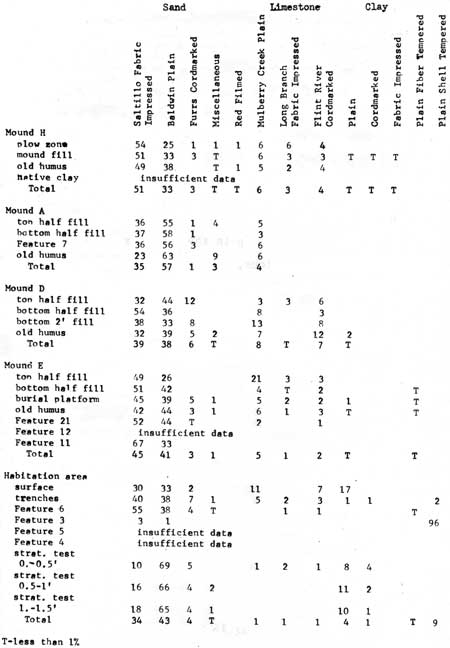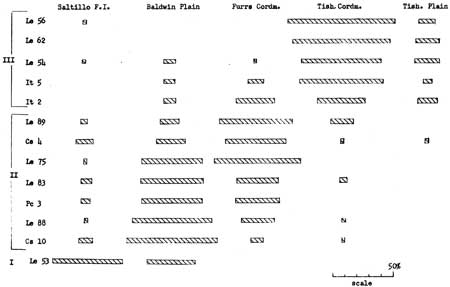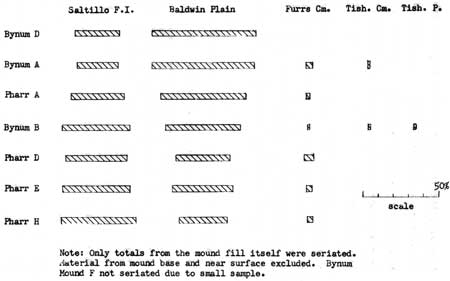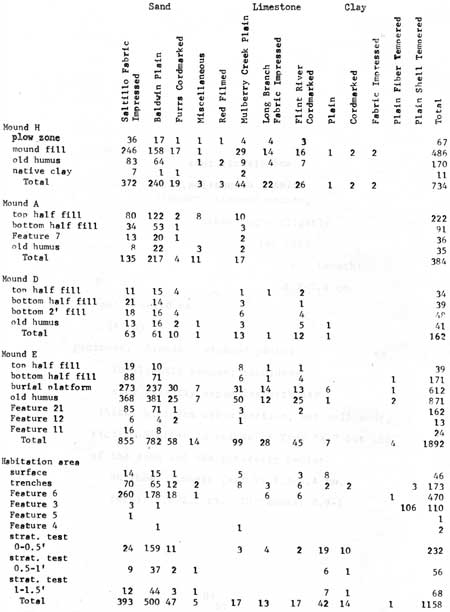|
NATCHEZ TRACE PARKWAY
Excavations at the Pharr Mounds and the Bear Creek Site |

|
CERAMIC ANALYSIS
The purpose of this section is to relate the Pharr Site culturally and temporally to other archeological units through an analysis of its ceramic assemblage.
The primary context into which the site must be fitted is the Miller ceramic sequence. Pottery relatable to this sequence was present in overwhelming numerical superiority and was doubtless the native ware of the builders of the Pharr mounds. The question of which period Pharr belongs in will involve, as will be shown below, information on the Miller sequence itself and on one of its key sites, Bynum. Before getting too far afield, however, let us first discuss the material recovered from the Pharr Site.
The whole vessels from the platform at Mound E are the only tight association evidence found and do not shed much light on the temporal placement of the site (table 1). Several were trade vessels or exotic forms which cannot be related temporally to the Miller sequence, and the single specimens of Baldwin Plain, Furrs Cordmarked, and Saltillo Fabric Impressed make up too small a sample on which to base any definite conclusions. We must therefore fall back on the evidence represented by the sherd assemblage.
TABLE 1.--Provenience of partial, nearly complete, and complete pottery vessels, Pharr Site
| Mound E surface burial platform | Mound E fill burial platform | Mound E Feature 10 | Mound E Feature 12 | Mound D top half fill | |
| Baldwin Plain | 1 | 1 | |||
| Furrs Cordmarked | 1 | ||||
| Saltillo Fabric Impressed | 1* | ||||
| Zone stamped, sand tempered | 3** | 1 | |||
| Flint River Cordmarked | 1 | ||||
| Flint River Brushed | 1* | 1 | |||
| Marksville Incised, var. Marksville | 1 | ||||
|
*partial vessel
**2 partial, 1 nearly complete | |||||
The initial problem in using the sherd assemblage is to determine whether the sherds, included fortuitously with the fill, are truly indicative of the age of the mounds or whether they date from an earlier occupation. In this regard, the relatively consistent percentage distribution of types throughout the excavation units would seem to be significant (table 2). The percentages recorded for the mounds are very close to those noted for their respective submound horizons. Furthermore, the percentages for the habitation area fall well within those for the mounds. The small number of Saltillo Fabric Impressed sherds recovered by screening in the stratigraphic tests in the habitation area is anomalous, but most of these sherds are small and badly weathered. Many of those identified as plain may originally have been fabric impressed.
TABLE 2.--Percentage distribution of sherd, Pharr Site

(click on image for a PDF version)
This consistency suggests that the mounds and the area from which the fill was obtained are essentially coeval and that there seems to be little question of significantly earlier material being included with mound fill. It can be argued, it is true, that the mounds were built just as Furrs Cordmarked was beginning to comprise a major percentage of the ceramic complex but before there was a chance for much of it to become available. The large quantities of Saltillo, which reaches its peak of popularity earlier, could be explained by an earlier occupation. This possibility cannot be absolutely denied, but it would appear to be less likely than the explanation offered. Had there been much Furrs Cordmarked around when the mounds were built, we would expect to find levels, features, or excavation units that contained a lot of it, and none were found.
The ceramic assemblage in the mounds would thus seem to reflect their true age. This assemblage, if the above arguments are correct, is characterized by high percentages of Saltillo Fabric Impressed and Baldwin Plain. Equally characteristic is Furrs Cordmarked, which, although it occurred in low quantities, was recovered consistently among the excavation units.
According to the existing framework of the Miller sequence (Cotter and Corbett, 1951, p. 33), Furrs Cordmarked is diagnostic of Miller II, whereas large percentages of Saltillo Fabric Impressed would indicate Miller I. An explanation of this apparent anomaly requires a review both of the Miller sequence itself and of the Bynum Site.
"Miller" is a ceramic complex which was first characterized by Jennings from data gathered in his excavations at the type site and from surface material collected at other sites in Lee County, Mississippi (Jennings, 1941, pp. 189-213). He later described the complex in terms of a sequence of three pottery assemblages or time periods: Miller I, characterized by fiber tempered pottery and sand tempered Saltillo Fabric Impressed; Miller II with the sand tempered Baldwin Plain and Furrs Cordmarked; and Miller III with the clay and grit tempered Tishomingo Plain and Tishomingo Cordmarked (Jennings, 1944, pp. 411-413). Cotter and Corbett subsequently used this sequence in assigning a time level to the Bynum Mounds. They presented the complex more formally than Jennings had done but made no essential changes in it (Cotter and Corbett, 1951, p. 33).
The complex depicted in these papers is one of neat blocks of time characterized by diagnostic pottery types. As these authors realized, the situation is greatly oversimplified. There is an additional body of data which will shed light on the Miller sequence: the surface collections made at sites in Chickasaw, Lee, Prentiss, and Itawamba Counties, Mississippi, which were gathered during the course of the Natchez Trace Parkway archeological survey. A large number of collections were gathered before World War II by Jennings and afterwards by Cotter and Corbett. Time did not permit a search for the collections amid the vast amount of uncataloged material stored at Ocmulgee National Monument. But Jennings had sorted and tabulated his pre-war collections and these data were available for seriation (Jennings, 1940).
The results of this seriation (table 3) presents a clearer picture of the Miller sequence and its components. Unfortunately, Miller I is poorly represented, but the single site recorded is bolstered by the pure Saltillo-Baldwin horizon at Bynum (Cotter and Corbett, 1951, p. 33). The table shows that Miller II is best defined as beginning when Baldwin Plain starts to decline in favor of Furrs Cordmarked. The latter type reaches its greatest popularity about the middle of the period. Miller III is ushered in when the clay-grit tempered types become more popular than the sand tempered types. Baldwin Plain and Furrs Cordmarked die out altogether during this period.
TABLE 3.--Seriation of surface collections of sherds
made by Jennings (1940).

(click on image for a PDF version)
The transition from Miller I to Miller II is poorly represented, and it will be seen that the Pharr assemblage cannot be fitted precisely into the table. Obviously, the site, with its quantities of Saltillo Fabric Impressed, fits more comfortably into Miller I than in the succeeding period. The presence of Furrs Cordmarked in the Miller I depiction, but a glance at the seriation chart (table 3) will show that it does no real violence to the scheme of things. It would suggest a time late in the period, however.
The Bynum Mounds are located in Chickasaw County, Mississippi, and comprise a key site of the Miller complex. A cursory examination shows that the mounds at both Bynum and Pharr manifest strong Hopewellian influences. This will be dealt with in a later section, but the similarity needs to be brought out now, for it plainly indicates that the two sites were generally contemporaneous. Since Pharr has been assigned to Miller I and the Bynum Mounds to Miller II (Cotter and Corbett, 1951, pp. 30-32). a review of the latter site is also in order.
Briefly, the situation at Bynum is as follows. Pure Baldwin-Saltillo horizons were sealed beneath the mounds. These types also dominated percentages in the fill of the four mounds excavated. A few sherds of Furrs Cordmarked, Tishomingo Plain, and Tishomingo Cordmarked were found in two of the mounds--all but a handful coming from within a foot of the surface. The other two mounds contained only Baldwin and Saltillo. In the village area, some features produced virtually pure Saltillo-Baldwin assemblages and others yielded these types mixed with later types. The mounds, and thus the period of Hopewellian influence, were assigned a Miller II time level on the basis of the Furrs Cordmarked and Tishomingo sherds. The large amount of Saltillo Fabric Impressed in the mounds was interpreted as a fortuitous association with fill obtained from a Miller I village area (Cotter and Corbett, 1951, pp. 22-35).
There is evidence at Bynum itself to suggest a Miller I level for the site. Surely the two mounds which yielded only Saltillo and Baldwin would fit here. Furthermore, the pure Saltillo-Baldwin horizons beneath all four of the Bynum mounds strongly suggest that in each case these strata were sealed by construction before appreciable quantities of the later types became available. Had Furrs Cordmarked or the Tishomingo types been extant in any significant quantities at the time the mounds were built, some would surely have shown up in the old soil horizon. True, the mounds could have been erected on an abandoned (Miller I) portion of the village, with the Miller II settlement being located elsewhere at the time the mounds were built. This still does not explain why there were no later sherds on the old ground surface, only a handful in the fill, and with the largest portion coming from within a foot of the surface. Mound building would have drawn people, with their pots, to the construction site. The pots were just as likely to get broken and the pieces included with the fill during the time of construction as afterward.
The importance of the few Furrs Cordmarked sherds as a time indicator of the mounds seems to have been exaggerated. This type is not, as has been suggested by the evidence at Pharr and in the seriation of surface collections, strictly diagnostic of Miller II.
The absence of fiber tempered pottery in the mounds, which the authors list as being diagnostic of Miller I (Cotter and Corbett, 1951, p. 33), might also have misled them. Fiber tempered pottery has been found on the surface of several northeast Mississippi sites with Saltillo Fabric Impressed but, so far as I am aware, a true association between the two has not been demonstrated. No one knows when Miller I began, and it is possible that fiber tempered pottery continued into the early part of the period. The data at Pharr show, however, that the Miller I assemblage persists into Hopewellian times, presumably long after fiber tempering had disappeared. The Miller I assemblage, in other words, need not be as early as Cotter and Corbett thought it to be.
The presence of Tishomingo Plain and Tishomingo Cordmarked sherds in an otherwise good Miller I assemblage at Bynum is frankly puzzling and not readily explainable. All we can suggest is that these types were accidentally introduced into the sample. Cotter and Corbett (1951, p. 19) observe that, ". . .Furrs is predominantly a sand tempered ware. But occasionally clay pellets and grit are noted. Since Tishomingo Cord is predominantly clay-grit tempered, but does contain some sand, the dividing line between the two is not sharp and distinct, and the type Furrs Cordmarked blends into the type Tishomingo Cordmarked." This is one possible explanation.
In short, the large quantity of Saltillo Fabric Impressed is held to be more indicative of the age of the Bynum mounds than a handful of types presumed to be later. The evidence, while not absolutely conclusive, at least strongly suggests that this was the case.
Although Bynum and Pharr share a late Miller I age, seriation of the pottery totals from the individual mounds demonstrate that the two sites are only partly contemporaneous (table 4). They overlap in time, with Bynum lasting somewhat later.
TABLE 4.--Seriation of sherds from mounds at
Bynum and Pharr Sites.

(click on image for a PDF version)
It may be noted also that the seriation of the Bynum and Pharr assemblages fits neatly at the bottom of the Miller II sites in table 3. We are perhaps splitting hairs by insisting on drawing the line at the top of the Bynum material; the placement of the dividing line between Miller I and Miller II is, after all, purely arbitrary. The significant fact is that Pharr and Bynum are roughly coeval.
A second cultural unit, the Marksville Phase, is intersected into the discussion by the recovery of three vessels. The Marksville Incised, var. Marksville, jar (fig. 12a) would seem to be an actual import from the south. The sand tempered, zone stamped vessels obviously represent a borrowed decorative technique applied to the indigenous paste. James B. Griffin (personal communication) states that the shape of the jar (fig. 13d) is reminiscent of specimens recovered at Marksville, suggesting the possible source of this borrowing.
The significance of the limestone tempered pottery at Pharr is uncertain. This ware has been found in Middle Woodland horizons in northwest Alabama and has been speculatively tied to the Copena Culture (DeJarnette, 1952, p. 277). The exact relationship has never, as far as I know, been precisely defined, however. Jennings asserted that Copena was later than the Miller complex (Jennings, 1941, p. 215), apparently on the basis that limestone tempered pottery is later than sand tempered pottery in northwest Alabama. In northeast Mississippi, however, limestone tempered pottery apparently never became dominant. Natchez Trace Parkway archeological survey records (Jennings, 1940) show that sherds of this ware, while found at many sites, were always very sparse. The data from Pharr suggest the contemporaneity of limestone tempering and sand tempering. Limestone tempered sherds turned up consistently, though usually in low numbers (table 5), and two limestone tempered vessels were found in graves at Mound E (fig. 12b and c). What this contemporaneity means in terms of Copena and Miller I is questionable, and will continue to be so until more is known about the relationship of Copena and limestone tempered pottery.
TABLE 5.--Provenience of sherds, Pharr Site.

(click on image for a PDF version)
The uncertain meaning of the clay tempered pottery has already been discussed. However, the presence of the Marksville Incised specimen does hint at an origin for the unnamed material.
All the shell tempered pottery came from a single trash pit in the village and clearly represents a later intrusion unrelated to the primary occupation.
| <<< Previous | <<< Contents>>> | Next >>> |
pharr_mounds-bear_creek/sec4-1.htm
Last Updated: 15-May-2008